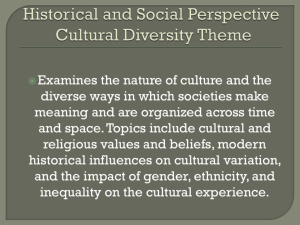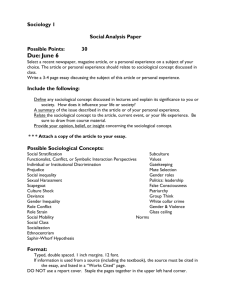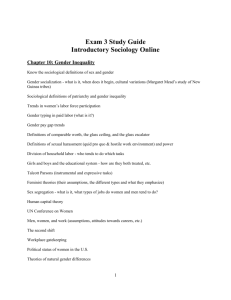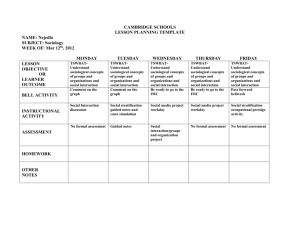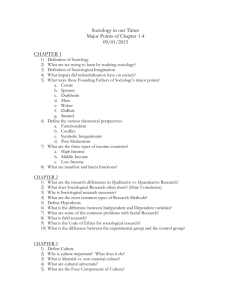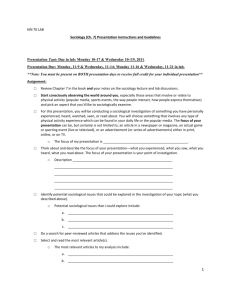Group
advertisement
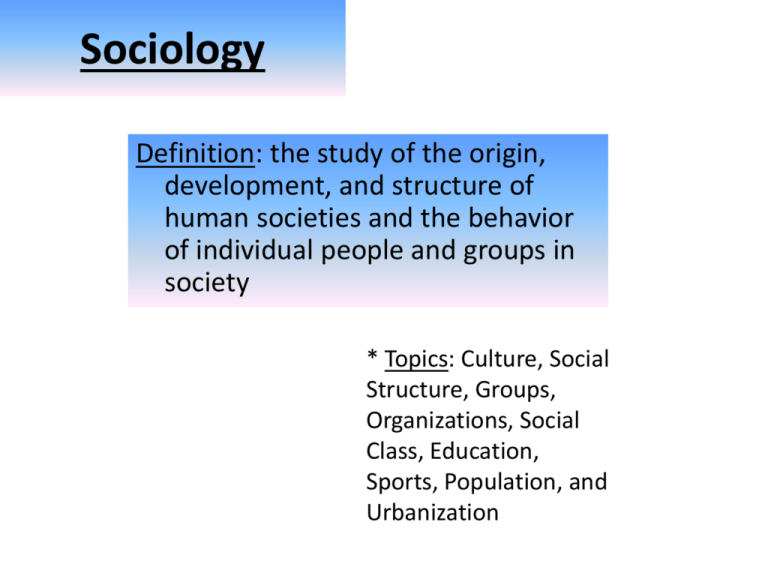
Sociology Definition: the study of the origin, development, and structure of human societies and the behavior of individual people and groups in society * Topics: Culture, Social Structure, Groups, Organizations, Social Class, Education, Sports, Population, and Urbanization • knowledge, language, values, customs, norms, and material objects • Varies from group to group • Explain human social behavior • Guide relationships with others • A structured community of people • Share a common culture • the way of passing or learning knowledge, skills, attitudes, and values from person to person Formal- deliberate & intentional Informal- through observation and imitation Primary- intimate, face to face groups Secondary- schools, churches, mass media I.) What is Socialization? Socialization: a process that begins at birth and is ongoing in which individuals learn human social behavior II.) Agents of Socialization Agents of Socialization: Members/groups within society that influence individual human social behavior Family School Peer Groups Mass Media Social Class Family Schools •Think, Speak, Norms, Values, • Hidden Curriculum Beliefs, Attitudes, Relationships, • discipline, order, cooperation, and Self-Image conformity • Rules & Regulations Peer Groups • make their own decisions • develop self-sufficiency • learn to get along with others • experiment Mass Media • serve as role models to imitate • teach ways of society Self Concept: Image of oneself separate from others “I” unlearned/spontaneous acts “Me”self-created acts of conformity Looking Glass Self: what you think others believe about you Perception Imagine Evaluate Significant Others: people whose opinions are most important to our self concept Role Taking: Seeing others through the eyes of someone else The Process: Imitation (18 months to 36 months) Play (3 years to 4 years) Game (5 years and up) Generalized Other: Rely less on others and more on understanding I.) What exactly is a Group? Group: at least two people who have one or more goals in common and share common ways of thinking and behaving II.) A “Group” is not Social Category: people who share a social characteristic Social Aggregate: people who are temporarily in the same place at the same time III.) A “Group” is Primary Group: people who know each other well, are emotionally close, and seek one another's company * Based on Primary Relationships (intimate, caring, personal, fulfilling) How to develop? • small in size • face to face contact • continual contact • social environment Examples: Best Friends Close Neighbors Play Groups Function? • emotional support • socialization • conformity Secondary Group: people who share only part of their lives and are together to accomplish a task or goal * Based on Secondary Relationships (impersonal, limited emotion) Examples: Clerks & Customers Work Groups Volunteers How to develop? • social environment • segment of person’s life Function? • to accomplish a goal • to complete a task Reference Group: a group used for self-evaluation by which one forms attitudes, beliefs, norms. In Groups Exclusive group that demands intense loyalty Out Groups Opposed by ingroup for competition and opposition Examples: Cliques, Teams, Countries, Races, Gangs, Neighborhoods IV.) Networks Social Network: all of a person’s social relationships • Not a “group” itself • Includes both “primary” & “secondary” groups Primary Groups (2) Social Aggregate Social Category Secondary Groups (2) In-Group I.) Social Stratification Definition: hierarchical arrangement of individuals into divisions based on dimensions within a society Based on following dimensions: Income Wealth Power Prestige Income: amount of money received within a given period of time by an individual or group Wealth: all economic resources possessed by an individual (everything you own) Power: ability to control the behavior of others (attached to the social positions we hold) Prestige: level of respect/admiration in which one is regarded by others (based on social position & voluntarily given) II.) Layers of Social Stratification Each layer represented by a “social class” Definition: economic or cultural arrangement of groups within a society based on variables Examples of Variables: • Education • Income • Occupation • Family • Power • Prestige III.) Social Inequality Definition: individuals in a society that do not have equal social status Examples of Social Inequality: • Economic: inequality based on distribution of wealth and income • Gender: obvious or hidden inequality of power/reward based on gender • Racial: unequal treatment based on physical characteristics IV.) Explanations of Stratification Conflict Theory: Inequality exists due to willingness of other to exploit people Inequality impedes progress Those whom have power keep others powerless to keep status quo Positions in society exist only as those in power deem them important V.) Class Consciousness Definition: the awareness of belonging to ones social class or socioeconomic status within a given society What is Social Mobility? Definition: Movement from one class —or more usually status group—to another Types of Social Mobility Horizontal Mobility Movement from one position to another within the same social level Ex: Changing jobs without altering occupational status Moving between social groups having the same social status. Vertical Mobility Movement from one social level to a higher one (upward mobility) or a lower one (downward mobility) Ex: Changing Jobs or Marrying Cultural diffusion from one social level to another The adoption by one economic class of the fashions current or formerly current in a higher class. Intergenerational Mobility Movement within or between social classes and occupations, the change occurring from one generation to the next Ex: Father to Son; Mother to Daughter Social Institutions “The Family” So, what exactly is a family? Family Definition: a group of people related by either blood, marriage, or adoption - definition varies from society to society - definition can change over time Family of Orientation: family that one is born into ∞ Gives name identity ∞ Give heritage ∞ Gives ascribed status ∞ Grants orientation to the world Family of Procreation: established upon marriage ∞ Legal to have children ∞ Gives name ∞ Becomes ones family of orientation ∞ Grants orientation to the world Social Institutions: “Education” I.) History of Schools and Education A. Early purpose: 1. Enculturation (passing of culture) 2. Socialization (passing social values & behaviors) B. Pre-Literate Societies: taught orally & by imitation by family & the community C. Literate Societies: taught literacy and basic skills Social Institutions: “Religion” I.) The Sociological Study of Religion A. Sociologists DO: 1. Examine the cultural and social aspects of religion that can be measured and observed B. Sociologists DO NOT: 1. Study the unobservable spiritual side 2. Determine which religions people should follow The Sociological Meaning of Religion A. Definition of Religion: 1. Unified system of beliefs & practices concerned with sacred things B. Sociological Separation: 1. Sacred: holy; set apart and dedicated to a religious purpose 2. Secular: not religious or spiritual in nature C. Sociological Observable Displays of Religion: (Religiosity) 1. Beliefs = what people consider as true (is a God vs. no God) 2. Rituals = private or public acts (church/prayer) 3. Intellectual Dimension = knowledge about faith (scripture) 4. Experience = feeling attached to expression (closeness to) 5. Consequences = decisions made based on religion (abstinence) Demography: The Study of Population • Demography – The study of human population • Fertility – The incidence of childbearing in a country’s population • Crude birth rate – The number of live births in a given year for every 1,000 people in a population • Mortality – The incidence of death in a country’s population • Crude death rate – The number of deaths in a given year for every 1,000 people in a population • Infant mortality rate – The number of deaths among infants under one year of age for each 1,000 live births in a given year • Life expectancy – The average life span of a country’s population • Migration – The movement of people into and out of a specified territory – Immigration • In-migration rate – Number of people entering an area for every 1,000 people in the population – Emigration • Out-migration rate – The number of people leaving for every 1,000 people – Both types usually happen at once • Push-pull factors • Demographic transition theory – Links population patterns to a society’s level of technological development – Stage 1 – Pre-industrial agrarian societies • High birth rate, high death rate – Stage 2 – Industrialization • Death rate falls, birth rates remain high – Stage 3 – Mature industrial economy • Birth rate drops, death rate drops – Stage 4 – Postindustrial economy • Demographic transition complete • Low-birth rate, steady death rate • Japan, Europe, and the U.S. • Environmental Deficit – Profound long-term harm to the natural environment caused by humanity’s focus on short-term material affluence • Environmental concerns are sociological • Environmental damage to air, land, or water is unintended • Environmental deficit is reversible – Societies create environmental problems – Societies can undo many of them What is Diversity? • Cultural diversity refers to the wide range of cultural differences found between and within nations – Can be a result of natural circumstances (climate, geography) or social circumstances (technology or demographics) – Societies can be homogeneous or heterogeneous – Heterogeneity in the U.S. (see chart – p. 91) Subculture • A category of people who share distinguishing attributes, beliefs, values, and/or norms that set them apart in some significant manner from the dominant culture. Counterculture • A group that strongly rejects dominant societal values and norms and seeks alternative lifestyles Ethnocentrism • The practice of judging all other cultures by one’s own culture • Based on the assumption that one’s own way of life is superior to all others – Can be positive or negative Why might this map be considered ethnocentric? Cultural Relativism • The belief that the behaviors and customs of any culture must be viewed and analyzed by the culture’s own standards Sociological Perspectives on Race and Ethnicity • Race – A group of people who have been identified as having real or alleged physical characteristics. It is the fact that these biological traits are endowed with social meaning that brings them into the realm of the social sciences. • Ethnicity – refers to people who share common cultural characteristics and ethnic identity; they share a sense of “oneness”, and a shared fate. • Marriage across racial and ethnic lines, while not uncommon, is not typical for sociological and demographic reasons; attitudes, beliefs, access. Race vs ethnicity • Race is often treated as ideology – ethnicity as a real phenomenon. • Racial refers mainly to physical terms, – ethnic rather to cultural terms. • Race refers to them, – ethnicity to us. • Both concepts always imply social relationship. Sociological Perspectives on Race and Ethnicity • Minority – a group that has less power than the dominant group, has less esteem and prestige, and is often the target of discrimination. The two major characteristics are distinctive identity and subordination. The sociological meaning of minority does not refer to the numerical size of a group, nor to any specific ethnicity, race, or other real or imaged factors as these factors are relative to a specific society. esteem – the honor that accrues to an individual filling a position prestige – the honor associated with an occupation or other position in a social system Sociological Perspectives on Race and Ethnicity • Prejudice – an attitude which predisposes an individual to prejudge entire categories of people unfairly. This attitude is rigid, often emotionally loaded, and resistant to change; “refencing” and closed mindedness. • Discrimination is a behavior resulting in unfair, unequal, or harmful treatment based upon a prejudice. • One may confront discrimination by focusing on attitudes, behaviors, or both. It is usually most effective to begin with the discriminatory behaviors in order to provide some relief for those discriminated against. The official organs of the state must support these efforts to eliminate discriminatory behaviors or they will most likely continue; institutional discrimination. Sociological Perspectives on Race and Ethnicity • Stereotype – a rigid and often inaccurate image that summarizes a belief. Because stereotypes reflect beliefs rather than facts, they are often illogical and self-serving. (Discussion) • Stereotypes persist in culture because: (functions for those using them) a) stereotypes can work to elevate the status of the group which engages in it; b) stereotyping reduces the need to think by creating “universals”, and not having to acknowledge individualistic characteristics; and, c) Stereotyping can work as a social-psychological mechanism for reducing guilt in the minds of those who practice prejudice and discrimination Sociological Perspectives on Race and Ethnicity • Stereotype –particular stereotypes are often used for different groups, such as the concept of “laziness”. Laziness has been applied to Blacks, Hispanics, Polish, Irish, and Native-Americans. It has also been used to explain why someone is the member of a lower class or poor. • COGNITIVE LEVEL – THE IDEA OR THOUGHT • JEWISH PEOPLE ARE GREEDY • EMOTIONAL LEVEL – ATTACHING FEELINGS TO IDEA • LEARNING TO FEEL ANGER TOWARDS WHITES • ACTION-ORIENTATION LEVEL – PREDISPOSITION TO ACT (discrimination) • MORE LIKELY TO VERBALLY OR PHYSICALLY ATTACK A TARGETTED GROUP • VERBALIZATION – JOKES, COMMENTS, RACIAL SLURS • EXCLUSION – KEEPING PEOPLE MARGINAL • AVOIDANCE – NOT TRAVELING IN CERTAIN AREAS • PHYSICAL ABUSE – PHYSICAL ATTACKS • GENOCIDE – SYSTEMATIC KILLING OFF OF A GROUP • PREJUDICE AND DISCRIMINATION BEGIN AS ETHNOCENTRIC ATTITUDES • AS A RESULT, GROUPS CAN BE PLACED IN A SITUATION WHERE THEY ARE SOCIALLY DISADVANTAGED AND LABELED • A GROUP’S SITUATION, OVER TIME, IS THUS EXPLAINED AS A RESULT OF INNATE INFERIORITY RATHER THAN LOOKING AT THE SOCIAL STRUCTURE FOR REASONS; THE CYCLE THEN REPEATS ITSELF

